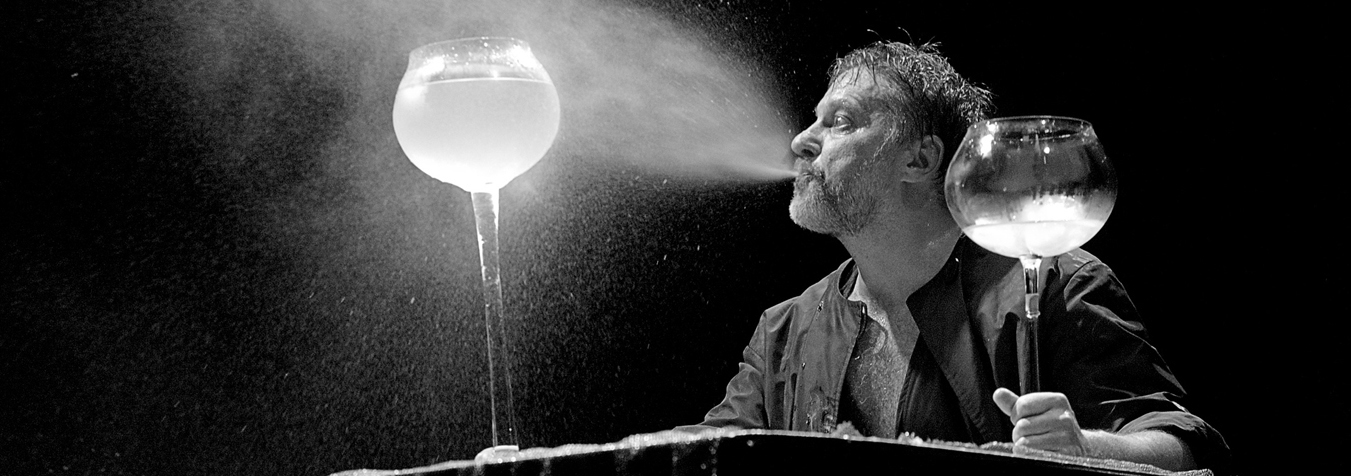In 1990, Jonas Vaitkus directed Adam Mickiewicz's Vėlinės (All Soul's Day) (set design by J. Arčikauskas, composition by A. Martinaitis), and Joshua Sobol's Ghetto (set design by Rasa Kriščiūnaitė, composition by Feliksas Bajoras) at the Academic Drama Theatre. At the end of that year, just before the bloody events of January 13, 1991 in Vilnius, when Soviet forces violently occupied the television broadcasting tower and other facilities, the production of Chekhov's The Cherry Orchard was performed under the direction of Rimas Tuminas (set design by Rita Daunoravičiūtė, composition by Faustas Latėnas). Soon after that, in the spring of 1991, Nekrošius premiered The Nose, based on the short story by Nikolai Gogol (set designed by N. Gutliajeva, composition by A. Martinaitis).
These stylistically, thematically and aesthetically very different debuts by the directing masters of the 1980s on the stages of a newly independent Lithuania were distinguished by the same motif of loss, saturated with the same farewell to a period that had suddenly receded into the past, and were full of a courage to accept the end, or "displacement", of the former world of theatre.
In All Soul's Day and Ghetto, Vaitkus resolutely proclaimed the end of theatre's mission as the herald of freedom and spoke with symbolic, expressively theatrical images of violence, coercion and suffering about "the deformed, crippled and ailing consciousness of the nation and each of its members as they awoke to freedom and were only beginning to liberate themselves from their nightmares". Rasa Vasinauskaitė, Laikinumo teatras: lietuvių režisūros pokyčiai 1990–2001 metais, Vilnius: Lietuvos kultūros tyrimų institutas, 2010, p. 50. Tuminas set the action in The Cherry Orchard in a dreary way station, with stranded and bitterly funny characters who had long ago lost their homes and had "gathered as if to bid farewell – not just to each other, but to time itself, to their own past" Ramunė Balevičiūtė, Rimas Tuminas: teatras, tikresnis už gyvenimą, Vilnius: Metodika, 2012, p. 197. that had seized what they treasured the most. In The Nose, Nekrošius unexpectedly "revealed the grotesque, ruthless and particularly self-ironic face of his theatre", Ramunė Marcinkevičiūtė, Eimuntas Nekrošius: erdvė už žodžių, Vilnius: Scena, Kultūros barai, 2002, p. 240–242. removing his own sacred aura, and that of "theatre's prophetic status" (as well as introducing a postmodern aesthetic to Lithuanian theatre through a blend of high and low style, irony, parody, reflections on banality, etc.)
The Cherry Orchard resounded with the greatest sensitivity at the start of the independence period, raising a level of public interest that was unusual for that time and that has lasted until today as the play continues to be a part of the Small Theatre's repertoire, albeit in a considerably different form. "I have no doubt that director Rimas Tuminas' The Cherry Orchard is a unique play in all of European theatre today," principally because of the "extraordinary circumstances in which it is performed," and because "it is very difficult to get in to see the play (the hall is packed every evening), although until quite recently it was difficult to get home at night because of the imminent curfew," theatre critic Valdas Vasiliauskas wrote at the start of 1991. He went on to note that The Cherry Orchard very accurately grasped and portrayed on stage the confusion, uncertainty and the feeling of having lost a real sense of time that marked the early 1990s. It created a unique impression of "haunted action, like on a ghost ship", almost forcing one to "pace outside the door" beyond which "their true, meticulously guarded lives live", while "offering you a kind of pseudo-story line". Valdas Vasiliauskas, „Vyšnių sodo“ orkestras (Apgulto miesto teatre)“, Lietuvos aidas, 1991-04-09, p. 3. After everyone else had fallen asleep, Gayev (Rimantas Bagdzevičius, Juozas Rygertas) paraded ceremoniously around with a bedpan; Simeonov-Pishchik (Mykolas Smagurauskas, Andrius Žebrauskas) couldn't bear it any longer and, pulling up a floor board, simply relieved himself; Lopakhin (Sigitas Račkys), in an attempt to convince Ranevskaya (Eglė Gabrėnaitė) that the estate was quite old, poked his cane through the ceiling causing a cupboard held in the attic to crash down onto the stage; Varya (Inga Burneikaitė, Larisa Kalpokaitė) stealthily took swigs of alcohol; Dunyasha (Eglė Čekuolytė) quietly appropriated a piece of Yasha's (Mindaugas Capas) secret dream: the spike at the top of a souvenir model of the Eiffel Tower.




Comments
Write a comment